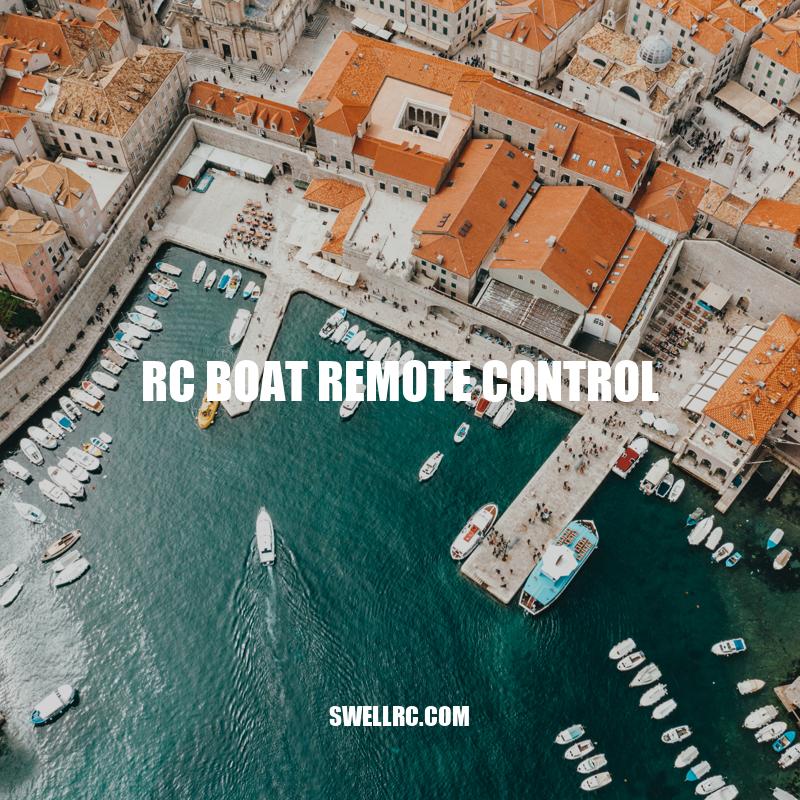Mastering RC Boat Remote Control: Tips, Types, and Components
RC Boat Remote Control: The Ultimate Guide
For many boating enthusiasts, remote-controlled boats provide an exciting way to cruise through calm lakes, race against friends or family, or simply enjoy the thrill of taking control of a speedy vessel. However, successfully operating an RC boat requires a lot more than just picking up a remote control and hitting the throttle. To navigate an RC boat effectively, you need to understand how the remote control works and how it communicates with the boat’s onboard electronics. In this guide, we’ll break down everything you need to know about RC boat remote controls, including how they work, the different types available, and essential factors to consider when choosing one. Additionally, we’ll share tips on how to use them effectively and how to keep your boat in great condition for maximum fun. So, let’s dive in and explore the wonderful world of RC boat remote controls!
Components of an RC Boat Remote Control
An RC boat remote control consists of two primary components: the transmitter and receiver. The transmitter is the remote you hold in your hand, while the receiver is the electronic device mounted on the boat that receives signals from the transmitter. Here are the details:
- The Transmitter: This typically features two joysticks or a stick-and-wheels setup that control the boat’s steering and speed. Most transmitters also include extra features such as trim adjustments, channel mixing and throttle and steering rate adjustment to let you control supplementary boat functions. The range of the transmitter can vary, with some entry-level models having as little as 50m range and high-end transmitters reaching up to 1km.
- The Receiver: This receives signals from the transmitter and sends them to the electronic speed control unit (ESU) and steering servo. It includes an antenna, which should be mounted in a location on the boat that can transmit signals from the transmitter with minimal interference. The frequency range of the receiver matches the transmitter you’re using – more on this in the next section.
It’s important to choose both a transmitter and receiver that are compatible with your boat’s electronic system. Most RC boat manufacturers include recommendations on remote controls in their user manuals. Some popular remote control systems for RC boats include the Spektrum and Futaba brands, which have a variety of models suited for different skill levels and boats. You can also find great RC boat remote control options at online retailers like Amazon and Hobbyking.
What are the components of an RC boat?
The components of an RC boat include a radio receiver, transmitter, motor, propeller, battery, speed controller, rudder, and hull. Additional components may include a servo, sound module, and GPS module. These components work together to control the boat’s movement and speed. For more information and to purchase RC boats, visit websites such as Horizon Hobby, Tower Hobbies, or Amazon.
RC boat remote control comes in two main types: pistol-grip and stick-type. Each type has its unique advantages and various models suited for different skill levels of boat operators. The pistol-grip transmitter looks similar to a gun handle, with the steering controls positioned on the side and the throttle located on the rear. It offers greater precision in control over throttle and steering. Meanwhile, the stick-type transmitter is held like a joystick and typically has two sticks that control the steering and throttle, respectively. It is easier to use for beginners and more affordable than pistol-grip transmitters, making it suitable for those in the beginner to intermediate skill level.
There are also different forms of remote control styles available, such as touch-screen tablets, computer software, and mobile apps. These are custom-made solutions that allow remote operation of the RC boat using a mobile device. Knowing the pros and cons of different types of remote control can help you choose a transmitter that suits your preferences and skill level, making your experience operating the RC boat more comfortable and enjoyable.
Additionally, certain RC boats may require a specific type of remote control, so always check the manufacturer’s recommendations before purchasing a transmitter. The earliest commercial RC boats appeared in the 1960s, and the first remote control system featured two frequencies: a one-chip transmitter and a 4-channel receiver. Today’s technology has advanced incredibly, enabling hobbyists to control boats with higher precision and realism. For example, newer RC boats use digital proportional control, which delivers more details of the boat’s direction and speed, making it feel more like you’re controlling a real boat.
Fun fact: The earliest commercial RC boats appeared in the 1960s.
What is a remote control boat?
A remote control boat is a model boat that can be operated from a distance using a wireless remote controller. It can be powered by electricity, gas, or even steam engines. Remote control boats are popular among hobbyists and can be found in various sizes and designs such as yachts, speedboats, and warships. If you are interested in buying remote control boats, you can check out websites such as Amazon, HobbyKing, and Horizon Hobby for a variety of options to choose from.
Factors to Consider When Choosing an RC Boat Remote Control
Choosing the right RC boat remote control is crucial to ensure optimal performance, ease of operation, and longer lifespan of the boat. There are several factors to consider when selecting the right remote control for your RC boat. Here are some key factors to keep in mind:
- Operating range: The operating range refers to the distance between the transmitter and the receiver. Consider the size of the body of water you plan to operate the boat in and choose a remote control system with a range that matches it.
- Frequency: The frequency is the bandwidth the remote control system operates on. Choose a remote control system that doesn’t interfere with other systems nearby or cause interference to other transmitters.
- Channels: The number of channels determines the number of functions you can control on the boat. Most transmitters come with 2 or 3 channels, sufficient to control basic functions such as steering and throttle. If you want to control additional features such as multiple motors, lighting, or sound effects, you’ll need a transmitter with more channels.
- Compatibility: Ensure that the remote control system is compatible with your RC boat’s electronic system. Different RC boats have different electronic setups, so check the manufacturer’s recommendations to avoid compatibility issues.
- Battery life: The remote control’s battery life affects how long you can operate the boat before having to recharge the batteries. Consider the transmitter’s battery type, capacity, and charging time to ensure that it suits your operating needs.
- Additional features: Some transmitters come with additional features such as trim adjustments, throttle and steering rate adjustment, and channel mixing, which allows you to control multiple functions simultaneously. Consider the features you need to ensure that you have optimal control over your RC boat.
Investing in a quality RC boat remote control can be expensive, but it’s worth it to ensure that you get the most out of your RC boat. Online retailers such as Amazon, Horizon Hobby, and Tower Hobbies offer a wide range of options for RC boat remote control. Always check customer reviews and ratings to compare products and make an informed decision.
How fast can remote control boats go?
There are sleek, well-designed, and powerful RC speed boats that can all hit over 50 mph. However, this seems to be the upper limit of speed for most RTR (Ready-to-Run) radio control boats. So, how fast remote control boats can go depends on the specific model and type of boat. For more information on RC speed boats and their capabilities, check out websites such as Tower Hobbies or Horizon Hobby.
Tips for Using an RC Boat Remote Control
Using an RC boat remote control effectively requires practice, patience, and skill. Here are some tips to help you become a pro at operating an RC boat:
- Practice in an open and safe environment: Always practice operating your RC boat in an open and safe environment away from other boats, swimmers, or any other obstacles. This will help you avoid accidents and collisions.
- Check batteries and electronic system: Before operating your RC boat, make sure the remote control batteries are fully charged, and the boat batteries are in good condition. This will ensure that you have a sufficient operating time and minimize the risk of malfunctions or damages.
- Be mindful of water conditions: Avoid water that is too shallow or has strong currents, as this can damage the boat or make it difficult to operate. Check the weather forecast and the water conditions before operating your RC boat.
- Start slow: When starting your RC boat, always start with slow speeds and gradually increase the speed as you gain confidence and experience. This will help you avoid accidents and minimize damages.
- Learn to use trim adjustments: Trim adjustments are essential for fine-tuning the steering and throttle of your RC boat. Take your time to learn how to use them effectively to get optimal performance.
- Join a community: Joining an RC boat community online or in your local area can help you learn new skills, get tips and advice, and meet other enthusiasts. Online forums such as RC Universe and RC Groups are excellent resources for finding information and connecting with other RC boat enthusiasts.
By following these tips and practicing regularly, you’ll be able to operate your RC boat like a pro. Remember to always take safety precautions and enjoy the experience.
How do remote control boats work?
Remote control boats work by having a radio transmitter that sends signals to a radio receiver on the boat. On the boat, the radio receiver is connected to two battery-powered electric motors or servos. Signals from the radio transmitter are interpreted by the radio receiver and translated into instructions to change the position of the servos. If you’re interested in buying a remote control boat, websites such as Amazon and Hobbyking offer a variety of options.
Conclusion
In conclusion, RC boat remote control is an essential component for operating an RC boat effectively. Choosing the right remote control system and understanding how to use it correctly can significantly improve your overall boat operating experience. Take your time to research and compare different remote control systems to find the one that suits your needs and preferences. Remember to practice in a safe and open environment, check your batteries and electronic system, be mindful of water conditions, and start slow when operating your RC boat. By following these tips and being patient and persistent, you’ll be able to master the art of operating an RC boat like a pro. Lastly, don’t forget to join an RC boat community to learn new skills, get tips and advice, and meet other enthusiasts. Have fun and enjoy the experience!



